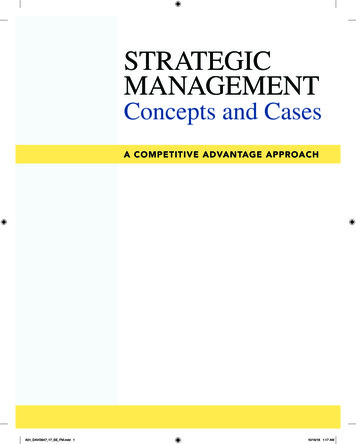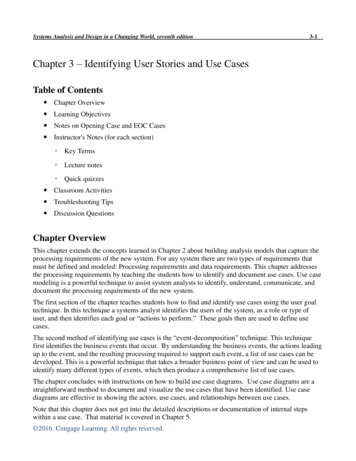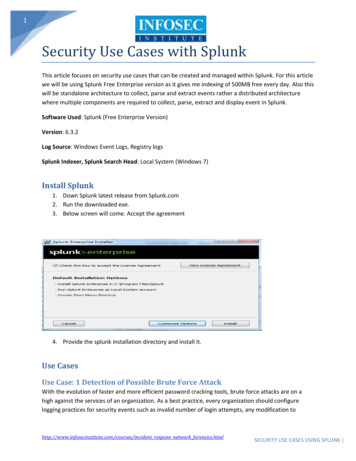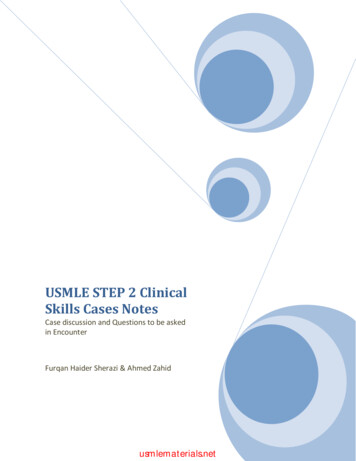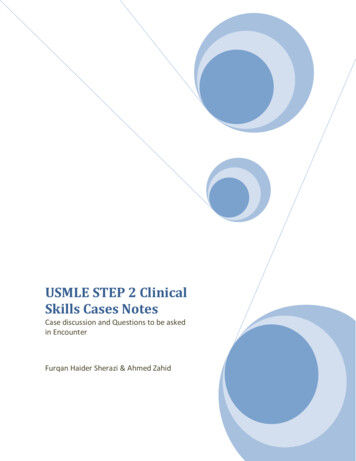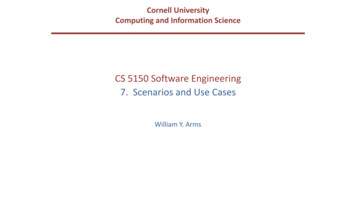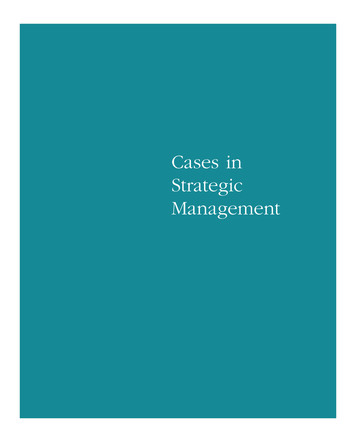
Transcription
tho1978X pt2.qxd10/18/200011:26 AMPage C-1Cases inStrategicManagement
tho1978X pt2.qxd10/18/200011:26 AMPage C-2A Guide to Case AnalysisI keep six honest serving men(They taught me all I knew);Their names are What and Why and When;And How and Where and Who.—Rudyard KiplingIn most courses in strategic management, students use cases about actual companies topractice strategic analysis and to gain some experience in the tasks of crafting and implementing strategy. A case sets forth, in a factual manner, the events and organizational circumstances surrounding a particular managerial situation. It puts readers atthe scene of the action and familiarizes them with all the relevant circumstances. Acase on strategic management can concern a whole industry, a single organization, orsome part of an organization; the organization involved can be either profit-seeking ornot-for-profit. The essence of the student’s role in case analysis is to diagnose and sizeup the situation described in the case and then to recommend appropriate action steps.WHY USE CASES TO PRACTICE STRATEGICMANAGEMENT?A student of business with tactAbsorbed many answers he lacked.But acquiring a job,He said with a sob,“How does one fit answer to fact?”The above limerick was used some years ago by Professor Charles Gragg to characterize the plight of business students who had no exposure to cases.1 The truth is thatthe mere act of listening to lectures and sound advice about managing does little foranyone’s management skills. Accumulated managerial wisdom cannot effectively bepassed on by lectures and assigned readings alone. If anything had been learned aboutthe practice of management, it is that a storehouse of readymade textbook answersdoes not exist. Each managerial situation has unique aspects, requiring its own diagnosis, judgment, and tailor-made actions. Cases provide would-be managers with avaluable way to practice wrestling with the actual problems of actual managers in actual companies.The case approach to strategic analysis is, first and foremost, an exercise in learning by doing. Because cases provide detailed information about conditions and problems of different industries and companies, your task of analyzing company aftercompany and situation after situation has the twin benefit of boosting your analyticalskills and exposing you to the ways companies and managers actually do things. Mostcollege students have limited managerial backgrounds and only fragmented knowledge1Charles I. Gragg, “Because Wisdom Can’t Be Told,” in The Case Method at the Harvard BusinessSchool, ed. M. P. McNair (New York: McGraw-Hill, 1954), p. 11.C-2
tho1978X pt2.qxd10/18/200011:26 AMPage C-3A Guide to Case Analysisabout companies and real-life strategic situations. Cases help substitute for on-the-jobexperience by (1) giving you broader exposure to a variety of industries, organizations,and strategic problems; (2) forcing you to assume a managerial role (as opposed to thatof just an onlooker); (3) providing a test of how to apply the tools and techniques ofstrategic management; and (4) asking you to come up with pragmatic managerial action plans to deal with the issues at hand.OBJECTIVES OF CASE ANALYSISUsing cases to learn about the practice of strategic management is a powerful way foryou to accomplish five things:21. Increase your understanding of what managers should and should not do in guiding a business to success.2. Build your skills in sizing up company resource strengths and weaknesses and inconducting strategic analysis in a variety of industries and competitive situations.3. Get valuable practice in identifying strategic issues that need to be addressed, evaluating strategic alternatives, and formulating workable plans of action.4. Enhance your sense of business judgment, as opposed to uncritically accepting theauthoritative crutch of the professor or “back-of-the-book” answers.5. Gaining in-depth exposure to different industries and companies, thereby acquiring something close to actual business experience.If you understand that these are the objectives of case analysis, you are less likely to beconsumed with curiosity about “the answer to the case.” Students who have growncomfortable with and accustomed to textbook statements of fact and definitive lecturenotes are often frustrated when discussions about a case do not produce concrete answers. Usually, case discussions produce good arguments for more than one course ofaction. Differences of opinion nearly always exist. Thus, should a class discussion conclude without a strong, unambiguous consensus on what do to, don’t grumble toomuch when you are not told what the answer is or what the company actually did. Justremember that in the business world answers don’t come in conclusive black-andwhite terms. There are nearly always several feasible courses of action and approaches,each of which may work out satisfactorily. Moreover, in the business world, when oneelects a particular course of action, there is no peeking at the back of a book to see ifyou have chosen the best thing to do and no one to turn to for a provably correct answer. The only valid test of management action is results. If the results of an action turnout to be good, the decision to take it may be presumed right. If not, then the actionchosen was wrong in the sense that it didn’t work out.Hence, the important thing for a student to understand in case analysis is that themanagerial exercise of identifying, diagnosing, and recommending builds your skills;discovering the right answer or finding out what actually happened is no more thanfrosting on the cake. Even if you learn what the company did, you can’t conclude thatit was necessarily right or best. All that can be said is “Here is what they did . . . ”2Ibid., pp. 12–14; and D. R. Schoen and Philip A. Sprague, “What Is the Case Method?” in The CaseMethod at the Harvard Business School, ed. M. P. McNair, pp. 78–79.C-3
tho1978X pt2.qxdC-410/18/200011:26 AMPage C-4Cases in Strategic ManagementThe point is this: The purpose of giving you a case assignment is not to cause youto run to the library or surf the Internet to discover what the company actually did but,rather, to enhance your skills in sizing up situations and developing your managerialjudgment about what needs to be done and how to do it. The aim of case analysis is foryou to become actively engaged in diagnosing the business issues and managerialproblems posed in the case, to propose workable solutions, and to explain and defendyour assessments—this is how cases provide you with meaningful practice at being amanager.PREPARING A CASE FOR CLASS DISCUSSIONIf this is your first experience with the case method, you may have to reorient yourstudy habits. Unlike lecture courses in which you can get by without preparing intensively for each class and have latitude to work assigned readings and reviews of lecture notes into your schedule, a case assignment requires conscientious preparationbefore class. You will not get much out of hearing the class discuss a case you haven’tread, and you certainly won’t be able to contribute anything yourself to the discussion.To get ready for class discussion of a case, you must study the case, reflect carefully on the situation presented, and develop some reasoned thoughts. Your goal shouldbe to end up with a sound, well-supported analysis of the situation and a sound, defensible set of recommendations. The Case-TUTOR software package that accompaniesthis edition will assist you in preparing the cases—it contains a set of study questionsfor each case and step-by-step tutorials to walk you through the process of analyzingand developing reasonable recommendations.To prepare a case for class discussion, we suggest the following approach:1. Skim the case rather quickly to get an overview of the situation it presents. Thisquick overview should give you the general flavor of the situation and indicatethe kinds of issues and problems you will need to wrestle with. If your instructorhas provided you with study questions for the case, now is the time to read themcarefully.2. Read the case thoroughly to digest the facts and circumstances. On this reading,try to gain full command of the situation presented in the case. Begin to developsome tentative answers to the study questions from your instructor or in the CaseTUTOR software package, which you can download at the Web site for the text. Ifyour instructor has elected not to give you assignment questions or has not recommended regular use of the Case-TUTOR, then start forming your own picture ofthe overall situation being described.3. Carefully review all the information presented in the exhibits. Often, there is animportant story in the numbers contained in the exhibits. Expect the informationin the case exhibits to be crucial enough to materially affect your diagnosis of thesituation.4. Decide what the strategic issues are. Until you have identified the strategic issuesand problems in the case, you don’t know what to analyze, which tools and analytical techniques are called for, or otherwise how to proceed. At times the strategic issues are clear—they are either stated directly in the case or easily inferredfrom it. At other times you will have to dig out the issues from all the information
tho1978X pt2.qxd10/18/200011:26 AMPage C-5A Guide to Case Analysis5.6.7.8.9.given; if so, the study questions and the case preparation exercises provided in theCase-TUTOR software will guide you.Start your analysis of the issues with some number crunching. A big majority ofstrategy cases call for some kind of number crunching—calculating assorted financial ratios to check out the company’s financial condition and recent performance, calculating growth rates of sales or profits or unit volume, checking outprofit margins and the makeup of the cost structure, and understanding whateverrevenue-cost-profit relationships are present. See Table 1 on the next page for asummary of key financial ratios, how they are calculated, and what they show. Ifyou are using Case-TUTOR, some of the number crunching has been computerizedand you’ll spend most of your time interpreting the growth rates, financial ratios,and other calculations provided.Apply the concepts and techniques of strategic analysis you have been studying.Strategic analysis is not just a collection of opinions; rather, it entails applying theconcepts and analytical tools described in Chapters 1 through 13 to cut beneath thesurface and produce sharp insight and understanding. Every case assigned is strategy related and presents you with an opportunity to usefully apply what you havelearned. Your instructor is looking for you to demonstrate that you know how andwhen to use the material presented in the text chapters. The case preparationguides on Case-TUTOR will point you toward the proper analytical tools needed toanalyze the case situation.Check out conflicting opinions and make some judgments about the validity of allthe data and information provided. Many times cases report views and contradictory opinions (after all, people don’t always agree on things, and different peoplesee the same things in different ways). Forcing you to evaluate the data and information presented in the case helps you develop your powers of inference and judgment. Resolving conflicting information comes with the territory because a greatmany managerial situations entail opposing points of view, conflicting trends, andsketchy information.Support your diagnosis and opinions with reasons and evidence. Most importantis to prepare your answers to the question “Why?” For instance, if after studyingthe case you are of the opinion that the company’s managers are doing a poorjob, then it is your answer to “Why do you think so?” that establishes just howgood your analysis of the situation is. If your instructor has provided you withspecific study questions for the case or if you are using the case preparationguides on Case-TUTOR, by all means prepare answers that include all the reasonsand number-crunching evidence you can muster to support your diagnosis. Workthrough the case preparation exercises on Case-TUTOR conscientiously, or, if youare using study questions provided by the instructor, generate at least two pagesof notes!Develop an appropriate action plan and set of recommendations. Diagnosis divorced from corrective action is sterile. The test of a manager is always to convertsound analysis into sound actions—actions that will produce the desired results.Hence, the final and most telling step in preparing a case is to develop an actionagenda for management that lays out a set of specific recommendations. Bear inmind that proposing realistic, workable solutions is far preferable to casually tossingout top-of-the-head suggestions. Be prepared to explain why your recommendationsC-5
tho1978X pt2.qxd10/18/2000C-611:26 AMPage C-6Cases in Strategic Managementtable 1 Key Financial Ratios, How They Are Calculated, and What They ShowRatioProfitability ratios1. Gross profit margin2. Operating profit margin(or return on sales)3. Net profit margin (or netreturn on sales)4. Return on total assets5. Return on stockholders’equity (or return on networth)6. Return on capitalemployed7. Earnings per shareLiquidity ratios1. Current ratio2. Quick ratio (or acid-testratio)3. Inventory to networking capitalLeverage ratios1. Debt-to-assets ratioHow CalculatedWhat It ShowsSales Cost of goods soldSalesProfits before taxes andbefore interestSalesAn indication of the total margin available tocover operating expenses and yield a profit.Profits after taxesSalesShows after-tax profits per dollar of sales.Subpar profit margins indicate that the firm’ssales prices are relatively low or that costsare relatively high, or both.An indication of the firm’s profitability fromcurrent operations without regard to theinterest charges accruing from the capitalstructure.Profits after taxesTotal assetsorProfit after taxes interestTotal assetsA measure of the return on total investment inthe enterprise. It is sometimes desirable toadd interest to the after-tax profits to formthe numerator of the ratio since total assetsare financed by creditors as well as bystockholders; hence, it is accurate to measurethe productivity of assets by the returnsprovided to both classes of investors.Profits after taxesTotal stockholders’ equityA measure of the rate of return on stockholders’investment in the enterprise.Profits after taxes Preferred stock dividendsTotal stockholders’ equity total debt Par value of preferred stockProfits after taxes and afterpreferred stock dividendsNumber of shares of commonstock outstandingShows the earnings available to the owners ofeach share of common stock.Current assetsCurrent liabilitiesIndicates the extent to which the claims ofshort-term creditors are covered by assetsthat are expected to be converted to cash ina period roughly corresponding to thematurity of the liabilities.Current assets InventoryCurrent liabilitiesInventoryCurrent assets Current liabilitiesTotal debtTotal assets2. Debt-to-equity ratioTotal debtTotal stockholders’ equityA measure of the rate of return on the totalcapital investment in the enterprise.A measure of the firm’s ability to pay off shortterm obligations without relying on the sale ofits inventories.A measure of the extent to which the firm’sworking capital is tied up in inventory.Measures the extent to which borrowed fundshave been used to finance the firm’soperations. Debt includes both long-term debtand short-term debt.Provides another measure of the fundsprovided by creditors versus the fundsprovided by owners.
tho1978X pt2.qxd10/18/200011:26 AMPage C-7A Guide to Case AnalysisC-7table 1 (concluded )RatioHow CalculatedWhat It ShowsLeverage ratios (cont.)3. Long-term debt-toequity ratioLong-term debtTotal stockholders’ equityA widely used measure of the balancebetween debt and equity in the firm’s longterm capital structure.4. Times-interest-earned(or coverage) ratioProfits before interest and taxesTotal interest chargesMeasures the extent to which earnings candecline without the firm becoming unable tomeet its annual interest costs.5. Fixed-charge coverageProfits before taxes and interest Lease obligationsTotal interest charges Lease obligationsA more inclusive indication of the firm’s abilityto meet all of its fixed-charge obligations.Activity ratios1. Inventory turnover2. Fixed assets turnover3. Total assets turnoverSalesInventory of finished goodsSalesFixed assetsSalesTotal assetsWhen compared to industry averages, itprovides an indication of whether a companyhas excessive or perhaps inadequate finishedgoods inventory.A measure of the sales productivity andutilization of plant and equipment.A measure of the utilization of all the firm’sassets; a ratio below the industry averageindicates the company is not generating asufficient volume of business, given the sizeof its asset investment.4. Accounts receivableturnoverAnnual credit salesAccounts receivableA measure of the average length of time ittakes the firm to collect the sales made oncredit.5. Average collection periodAccounts receivableTotal sales 365orAccounts receivableAverage daily salesIndicates the average length of time the firmmust wait after making a sale before itreceives payment.Other ratios1. Dividend yield oncommon stockAnnual dividends per shareCurrent market price per shareCurrent market price per shareAfter-tax earnings per shareA measure of the return to owners received inthe form of dividends.3. Dividend payout ratioAnnual dividends per shareAfter-tax earnings per shareIndicates the percentage of profits paid out asdividends.4. Cash flow per shareAfter-tax profits DepreciationNumber of common sharesoutstanding2. Price-earnings ratioFaster-growing or less-risky firms tend tohave higher price-earnings ratios thanslower-growing or more-risky firms.A measure of the discretionary funds over andabove expenses that are available for use bythe firm.Note: Industry-average ratios against which a particular company’s ratios may be judged are available in Modern Industry and Dun’sReviews published by Dun & Bradstreet (14 ratios for 125 lines of business activities), Robert Morris Associates’ Annual StatementStudies (11 ratios for 156 lines of business), and the FTC-SEC’s Quarterly Financial Report for manufacturing corporations.
tho1978X pt2.qxdC-810/18/200011:26 AMPage C-8Cases in Strategic Managementare more attractive than other courses of action that are open. You’ll find Case-TUTOR’S case preparation guides helpful in performing this step, too.As long as you are conscientious in preparing your analysis and recommendations,and have ample reasons, evidence, and arguments to support your views, you shouldn’tfret unduly about whether what you’ve prepared is “the right answer” to the case. Incase analysis there is rarely just one right approach or set of recommendations. Managing a company and crafting and executing strategies are not such exact sciences thatthere exists a single provably correct analysis and action plan for each strategic situation. Of course, some analyses and action plans are better than others; but, in truth,there’s nearly always more than one good way to analyze a situation and more than onegood plan of action. So, if you have carefully prepared the case using either the CaseTUTOR case preparation guides or your instructor’s assignment questions, don’t loseconfidence in the correctness of your work and judgment.PARTICIPATING IN CLASS DISCUSSION OF A CASEClassroom discussions of cases are sharply different from lecture classes. In a caseclass students do most of the talking. The instructor’s role is to solicit student participation, keep the discussion on track, ask “Why?” often, offer alternative views, playthe devil’s advocate (if no students jump in to offer opposing views), and otherwiselead the discussion. The students in the class carry the burden of analyzing the situation and of being prepared to present and defend their diagnoses and recommendations. Expect a classroom environment, therefore, that calls for your size-up of thesituation, your analysis, what actions you would take, and why you would take them.Do not be dismayed if, as the class discussion unfolds, some insightful things are saidby your fellow classmates that you did not think of. It is normal for views and analyses to differ and for the comments of others in the class to expand your own thinkingabout the case. As the old adage goes, “Two heads are better than one.” So it is to beexpected that the class as a whole will do a more penetrating and searching job of caseanalysis than will any one person working alone. This is the power of group effort, andits virtues are that it will help you see more analytical applications, let you test youranalyses and judgments against those of your peers, and force you to wrestle with differences of opinion and approaches.To orient you to the classroom environment on the days a case discussion is scheduled, we compiled the following list of things to expect:1. Expect the instructor to assume the role of extensive questioner and listener.2. Expect students to do most of the talking. The case method enlists a maximum ofindividual participation in class discussion. It is not enough to be present as asilent observer; if every student took this approach, there would be no discussion.(Thus, expect a portion of your grade to be based on your participation in casediscussions.)3. Be prepared for the instructor to probe for reasons and supporting analysis.4. Expect and tolerate challenges to the views expressed. All students have to be willing to submit their conclusions for scrutiny and rebuttal. Each student needs tolearn to state his or her views without fear of disapproval and to overcome the hesitation of speaking out. Learning respect for the views and approaches of others isan integral part of case analysis exercises. But there are times when it is OK to
tho1978X pt2.qxd10/18/200011:26 AMPage C-9A Guide to Case Analysisswim against the tide of majority opinion. In the practice of management, there isalways room for originality and unorthodox approaches. So while discussion of acase is a group process, there is no compulsion for you or anyone else to cave inand conform to group opinions and group consensus.5. Don’t be surprised if you change your mind about some things as the discussionunfolds. Be alert to how these changes affect your analysis and recommendations(in the event you get called on).6. Expect to learn a lot in class as the discussion of a case progresses; furthermore,you will find that the cases build on one another—what you learn in one case helpsprepare you for the next case discussion.There are several things you can do on your own to be good and look good as aparticipant in class discussions: Although you should do your own independent work and independent thinking,don’t hesitate before (and after) class to discuss the case with other students. Inreal life, managers often discuss the company’s problems and situation with otherpeople to refine their own thinking.In participating in the discussion, make a conscious effort to contribute, rather thanjust talk. There is a big difference between saying something that builds the discussion and offering a long-winded off-the-cuff remark that leaves the class wondering what the point was.Avoid the use of “I think,” “I believe,” and “I feel”; instead, say, “My analysisshows—” and “The company should do . . . because—” Always give supportingreasons and evidence for your views; then your instructor won’t have to ask you“Why?” every time you make a comment.In making your points, assume that everyone has read the case and knows what itsays; avoid reciting and rehashing information in the case—instead, use the dataand information to explain your assessment of the situation and to support yourposition.Bring the printouts of the work you’ve done on Case-TUTOR or the notes you’veprepared (usually two or three pages’ worth) to class and rely on them extensivelywhen you speak. There’s no way you can remember everything—especially the results of your number crunching. To reel off the numbers or to present all five reasons why, instead of one, you will need good notes. When you have preparedthoughtful answers to the study questions and use them as the basis for your comments, everybody in the room will know you are well prepared, and your contribution to the case discussion will stand out.PREPARING A WRITTEN CASE ANALYSISPreparing a written case analysis is much like preparing a case for class discussion, except that your analysis must be more complete and put in report form. Unfortunately,though, there is no ironclad procedure for doing a written case analysis. All we can offer are some general guidelines and words of wisdom—this is because company situations and management problems are so diverse that no one mechanical way toapproach a written case assignment always works.C-9
tho1978X pt2.qxdC-1010/18/200011:26 AMPage C-10Cases in Strategic ManagementYour instructor may assign you a specific topic around which to prepare your written report. Or, alternatively, you may be asked to do a comprehensive written caseanalysis, where the expectation is that you will (1) identify all the pertinent issues thatmanagement needs to address, (2) perform whatever analysis or evaluation is appropriate, and (3) propose an action plan and set of recommendations addressing the issues you have identified. In going through the exercise of identify, evaluate, andrecommend, keep the following pointers in mind.3IdentificationIt is essential early on in your paper that you provide a sharply focused diagnosis ofstrategic issues and key problems and that you demonstrate a good grasp of the company’s present situation. Make sure that you can identify the firm’s strategy (use the concepts and tools in Chapters 1–10 as diagnostic aids) and that you can pinpoint whateverstrategy implementation issues may exist (consult the material in Chapters 11–13 for diagnostic help). Consult the key points we have provided at the end of each chapter forfurther diagnostic suggestions. Review the study questions for the case on Case-TUTOR.Consider beginning your paper with an overview of the company’s situation, its strategy,and the significant problems and issues that confront management. State problems/issues as clearly and precisely as you can. Unless it is necessary to do so for emphasis,avoid recounting facts and history about the company (assume your professor has readthe case and is familiar with the organization).Analysis and EvaluationThis is usually the hardest part of the report. Analysis is hard work! Check out thefirm’s financial ratios, its profit margins and rates of return, and its capital structure,and decide how strong the firm is financially. Refer back to Table 1, which contains asummary of various financial ratios and how they are calculated. Use it to assist inyour financial diagnosis. Similarly, look at marketing, production, managerial competence, and other factors underlying the organization’s strategic successes and failures.Decide whether the firm has valuable resource strengths and competencies and, if so,whether it is capitalizing on them.Check to see if the firm’s strategy is producing satisfactory results and determinethe reasons why or why not. Probe the nature and strength of the competitive forcesconfronting the company. Decide whether and why the firm’s competitive position isgetting stronger or weaker. Use the tools and concepts you have learned about to perform whatever analysis or evaluation is appropriate. Work through the case preparationexercise on Case-TUTOR if one is available for the case you’ve been assigned.In writing your analysis and evaluation, bear in mind four things:1. You are obliged to offer analysis and evidence to back up your conclusions. Do notrely on unsupported opinions, overgeneralizations, and platitudes as a substitutefor tight, logical argument backed up with facts and figures.3For some additional ideas and viewpoints, you may wish to consult Thomas J. Raymond, “WrittenAnalysis of Cases,” in The Case Method at the Harvard Business School, ed. M. P. McNair, pp. 139–63.Raymond’s article includes an actual case, a sample analysis of the case, and a sample of a student’s written report on the case.
tho1978X pt2.qxd10/18/200011:26 AMPage C-11A Guide to Case Analysis2. If your analysis involves some important quantitative calculations, use tables andcharts to present the calculations clearly and efficiently. Don’t just tack the exhibits on at the end of your report and let the reader figure out what they mean andwhy they were included. Instead, in the body of your report cite some of the keynumbers, highlight the conclusions to be drawn from the exhibits, and refer thereader to your charts and exhibits for more details.3. Demonstrate that you have command of the strategic concepts and analytical toolsto which you have been exposed. Use them in your report.4. Your interpretation of the evidence should be reasonable and objective. Be waryof preparing a one-sided argument that omits all aspects not favorable to your conclusions. Likewise, try not to exaggerate or overdramatize. Endeavor to inject balance into your analysis and to avoid emotional rhetoric. Strike phrases such as “Ithink,” “I feel,” and “I believe” when you edit your first draft, and write in “Myanalysis shows,” instead.RecommendationsThe final section of the written case analysis should consist of a set of definite recommendations and a plan of action. Your set of recommendations should address all of theproblems/issues you identified and analyzed. If the recommendations come as a surprise or do not follow logically from the analysis, the effect is to weaken greatly yoursuggest
plementing strategy. A case sets forth, in a factual manner, the events and organiza-tional circumstances surrounding a particular managerial situation. It puts readers at the scene of the action and familiarizes them with all the relevant circumstances. A case on strategic management
